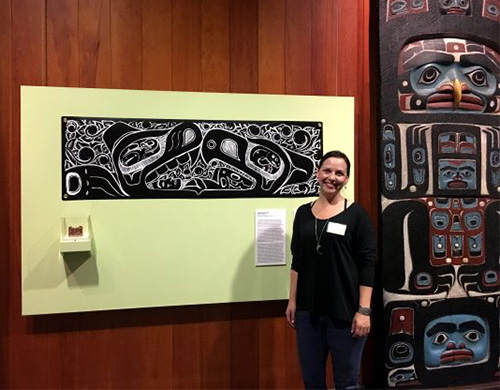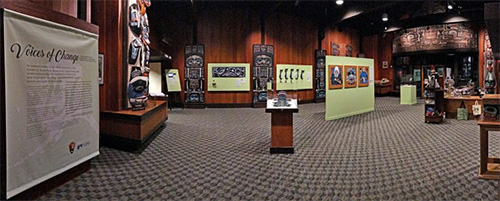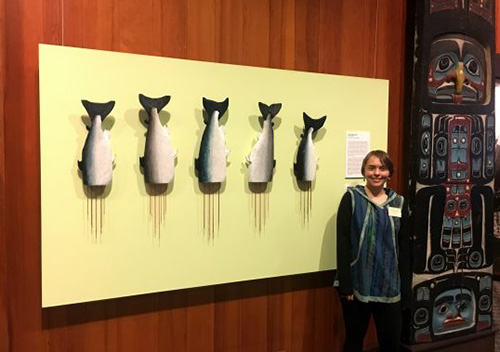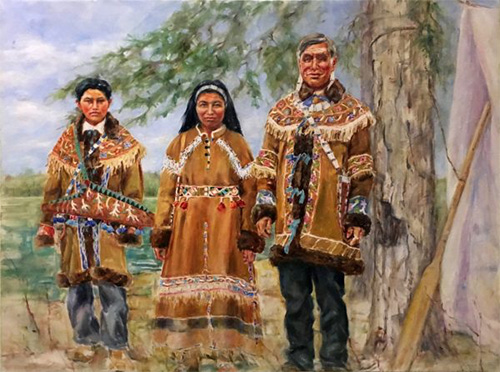
Artwork examines 1867 transfer of Alaska to the U.S.By THERESA BAKKER
April 14, 2017
“I find it hard to accept that people could purchase land without regard to who it really belonged to and use the natural resources without proper precautions and respect,” she said. So she did something about it. She created a work of art to express her feelings. “Selling Alaska” is now on display at the Sitka National Historical Park as part of the exhibit Voices of Change: Perspectives on the Transfer of Alaska from Russia to the United States. The artworks on display all depict artistic interpretations of the responses of Alaska Native peoples to the transfer of Alaska in 1867.
Sitka artist Mary Goddard stands with her artwork “Selling Alaska,” a copper cuff and a digital print on vinyl.
The treaty explicitly excluded Alaska Natives from the rights and freedoms offered to white inhabitants. Gomez said the artwork conveys a sense of the broad effects this marginalization had on Alaska Natives. “I was impressed with the historical research, creative insight and emotional response each of the artists put into their projects. They responded with thoughtful projects that together create an exhibit that illustrates the impacts of the transfer,” she said. Goddard said she wanted her artwork to feel both contemporary and relevant. “Looking back, I can imagine how the Tlingit people must have felt when their land was sold,” she said. “I wanted to tell the story in a way that my ancestors would. I wanted to capture people’s attention but pull them in to really look at the art and discover its message.” Kelsey Lutz, the Sitka National Historical Park curator, said the exhibit expresses the personal experience of those who were affected by the change and plays an important role in humanizing an otherwise political event. “At its core, this exhibit carries a message about the cultural diversity that exists in Alaska,” Lutz said. “The exhibit is intended to provide a wide breadth of perspectives about the transfer of Alaska to the U.S. It is important to remember that we are commemorating the anniversary of the sale rather than celebrating it. Not everything that came out of the transfer was positive.” While many of the pieces in the exhibit capture a feeling of loss, she said, they also demonstrate the vibrancy of Native culture today.
The Voices of Change exhibit fills the Sitka National Historical Park visitor center. The exhibit will remain through November 2017.
The artwork includes paintings, sculptures, digital art, beadwork and metalwork. A Boston-area artist also installed a project on the park’s Totem Loop Trail that explores the legal and legislative response to the treaty. University of Alaska Fairbanks graduate Erin Gingrich created a work titled “Fragile Wealth” that features five carved salmon hung headless in a row. She said the artwork focuses on the beauty of the state’s natural resources, the meaning that comes with harvesting the fish from her own environment and the understanding that these resources are a gift. “The exhibit recognizes that Alaska Natives have survived and acknowledges us as a living people,” she said. “My inclusion is important to me because raising awareness about our historical way of life and its evolution to today’s subsistence rights is a key part of my work.”
Anchorage artist Erin Gingrich stands with her artwork, “Fragile Wealth,” at the opening of the Voices of Change exhibit at the Sitka National Historical Park.
Austen said she researched the painting using objects preserved in the collections at the UA Museum of the North. “I used samples of chiefs moose hide jackets and beadwork from that time to get the details and colors right. What luck that the gorgeous dress Martha is wearing is actually on display at the museum.”
Karen Austen painted this work, titled
Sitka NHP is the only national park in Alaska commemorating the sesquicentennial this year, in part because it is the only national park tasked with interpreting the Russian America period. Established in 1890, Sitka NHP is Alaska’s smallest national park but also its oldest. The park preserves the site where the Tlingit people were finally defeated by the Russians in 1804 after defending their wooden fort for a week. Voices of Change will be on display at Sitka NHP through most of the sesquicentennial year. Lutz said it will be available to the public until the end of November. “We hope the exhibit will generate dialogue about the hardships of the past as well as the healing that needs to happen for the future,” she said.
On the Web:
This article is provided as a public service by the
Representations of fact and opinions in comments posted are solely those of the individual posters and do not represent the opinions of Sitnews.
|
||



